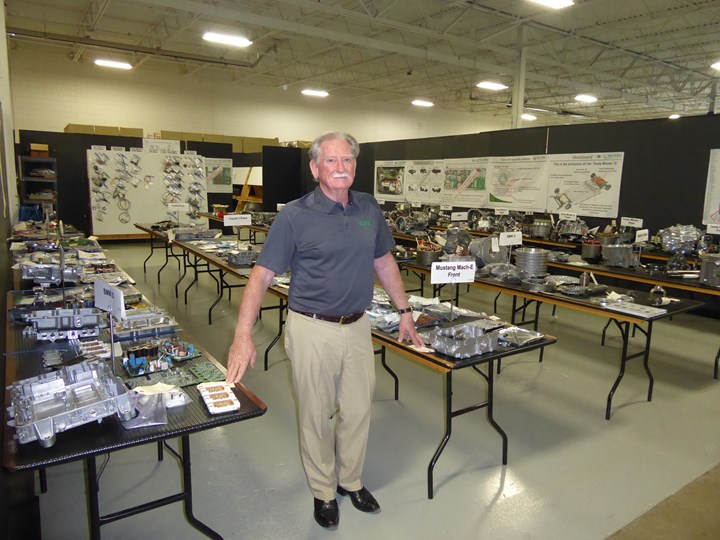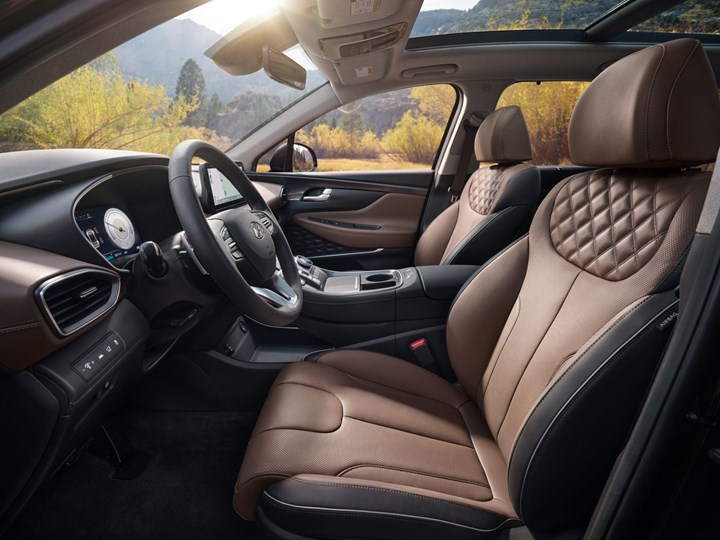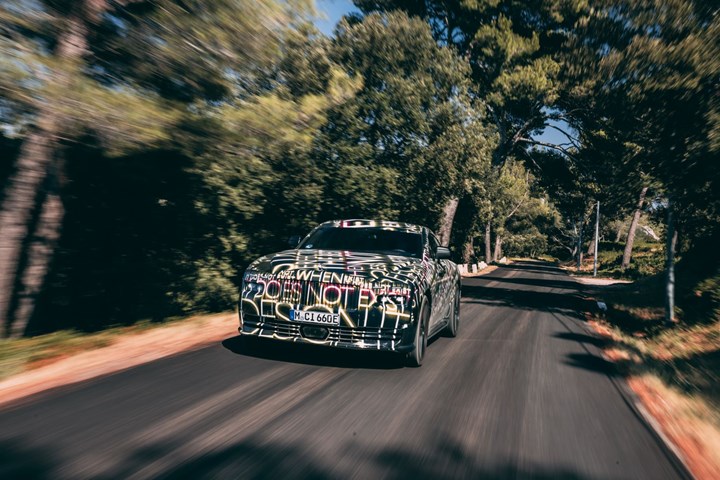on Munro, Colorado powertrain approach, Hyundai Santa Fe Hybrid, Rolls Spectre, ADAS terms
Sandy Munro talks. . .Colorado’s powertrain approach. . .Hyundai Santa Fe Hybrid. . . Lesson from Sir Henry Royce. . .ADAS nomenclature
Munro Live!

Lean design and manufacturing expert Sandy Munro in his facility. Those tables are covered with EV powertrain systems that he and his team have disassembled and analyzed. (Image: gsv)
Sandy Munro is the founder of a product teardown, analysis, costing, and lean design consulting firm, Munro & Associates. I’ve known Munro for some 30 years, from back when his company was just a handful of individuals who were dedicated to promoting ideas like design for manufacturing, which seemed to be interesting to a handful of people in the industry. Those that listened benefited from his approach.
Sandy has always been thoughtful—but controversial. He doesn’t suffer fools gladly, as they say.
Now he has more than 300,000 subscribers to his YouTube channel.
An interview he did with Elon Musk last year has 3.2-million views.
Yes, it seems like a guy who is steeped in lean design has become an overnight sensation—after promoting it for decades.
For the past few years Munro and his colleagues—there are 108 of them now in a large facility in Auburn Hills, Michigan, nearby the FCA US headquarters (though Munro says with a verbal eye-roll that they don’t work with Stellantis because he’s been told that the folks at Stellantis think their products should be benchmarked)—have been spending doing things like working with companies in China (he thinks that when—not if—Chinese companies start bringing their product to the U.S. the competition is going to be stiff) and concentrating their efforts on performing teardowns on EVs. Munro says they decided that EVs is where the industry is going, and Munro & Associates want to be part of it. Many companies, he suggests, are unwilling to acknowledge the change that is occurring and so will be, to put it nicely, left behind.
A couple weeks ago I spent time with Sandy in his office—which is “guarded” by a full-size whimsical-yet-menacing sculpture of the Predator creature from the movie of that name that was built by a client entirely out of. . . auto parts (e.g. timing chains for the dreads)—and walking around his shop, where I saw the top of a Tesla Model Y battery pack being peeled back and was schooled in gigacasting while standing beneath a Model Y frame on a hoist, to name but a few highlights.
And here is some of what I learned in Munro’s own words.
EVs Are Going to Happen—In a Big Way
“The tipping point is 5%, which will hit this year for EV sales in the U.S. Once you hit 5%, then I believe next year will be 10% then 20% the year after then 40%. . . .It is like Moore’s Law for cars.”
Which Traditional Suppliers Are OK for the Transition
“What people fail to recognize is that these vehicles are much heavier than a conventional car. The battery packs are heavy. Companies making anything that has to do with suspension are OK.”
However, There Are Some Changes
“Because of Tesla, the ride characteristics have to change. If it doesn’t have a BMW feel—5-bar link in the back and virtual ball on the front—people won’t want it. They want that Tesla ride.”
Other Suppliers Still Needed, Too
“Look at the inside of a car. There are still seats and instrument panels.”
But. . .
“There is a movement back to internalizing some of these things after Tesla showed the way—they make their own seats, IPs, cut own carpet, own headliners. They’re not adhering to the Harvard rules, which have it that you outsource and offshore.”
Stampers OK
“Another thing that’s not going away is stamping.”
But. . .
“But some stampers will see serious competition with these gigacastings. That will make a big difference, not only to the stampers but to the floor space needed.
“Take into account everything you need for the front end or rear end of vehicle that eliminated by going to giant castings; you just lost somewhere between 35 and 50% of the floor space needed for a traditional stamping line. You need a couple big die-casting presses.”
Gigacasting Machines & Machining
“People need 6,000- or 8,000-ton machines. One company ordered 9,000-ton machines.
“It shoots 150 pounds of molten aluminum into a tiny cavity in a short period of time. The parts don’t need any heat treating. You don’t worry about warpage. If you drill holes in it, you won’t induce stresses.
“After casting there are some flat spots and holes that need to be spot-faced and drilled for the suspension. And location points for body to drop on.
“There is not that much machining—99% of the surfaces are fine the way they are.”
Moldmakers Good, But. . .
“Tool and mold people will do well. But getting into that type of business will need some help.”
Powertrain Supplier? (Gulp)
“The guys who are going to lose the most are those in the transmission and engine business. They’re doomed. It will be a slow death.”
“It is not like they’re going to vanish quickly—I don’t think you’re going to get rid of ICE vehicles until maybe 2045-2050, and it may take some sort of buy-back to scrap them out.”
A Big Difference
“I came from the engine division at Ford. There are a tremendous number of parts that have to fit perfectly together for an engine.
“In the case of electric motors, you stamp and glue or staple rotors together. The stator has windings, or better, it uses hair pins. It doesn’t take long to put them together.
“It used to be you had whole factories to make pistons, con rods, con rod caps, bearing caps, crankshafts, cylinder heads, valves. . . . They don’t need them anymore.”
Poof!
“It used to be that there were Tier One, Tier Two and Dis-a-tier. Now it will be Tier One and Dis-a-tier.”
What Suppliers Need to Ask Themselves
“’What is it I can do not with my existing equipment, because I will sell it, but what will allow me to get out of what I’m in now and into something with a future?’
“We’ve had dozens of companies that have asked us to give them a hand: what has a future, how do we get into it, what do we do with our company to make us viable?”
“If they’re family owned, better tell the kids to get a new job.”
Who’s Laughing Now?
“I’ve been saying for years vertical integration is a good deal. Quite a few times people would smirk or laugh out loud.
“It was the same thing with body-on-frame for electric vehicle. Looking at its versatility, body-on-frame is what you have to go to.”
Make It or Not
“Some companies are going to make the transition.
“Other won’t because of denial and fear. They don’t want to change because they’re afraid. Or if they think that if they say it won’t happen it won’t happen. It will.”
Where We Are
“This is what the future is.
“I feel sorry for a lot of people who made some bad judgment calls and haven’t started working toward the transition.”
>>>
’23 Chevy Colorado’s Clever Powertrain Approach

‘23 Chevy Colorado Trail Boss. Like the other models in the lineup of the all-new midsize, it has a 2.7-liter turbo. In its case, 310 hp, 390 lb-ft of torque. (Image: Chevrolet)
Chevrolet unveiled the 2023 Colorado pickup last week.
The all-new midsize will be available as WT, LT, Z71, ZR2 and Trail Boss models. There are three chassis stances (standard for WT, LT an Z71); two-inch factory lifted, ultra-wide stance (Trail Boss); high-performance three-inch factory installed lift and wide stance (ZR2).
But here’s the clever bit
There are three powertrain offerings.
All based on one 2.7-liter turbocharged engine (borrowed from the full-size Silverado).
That is:
- There is the version standard in the WT and LT that produces 237 hp, 259 lb-ft of torque and provides a max trailering capacity of 3.500 pounds. (This bests the current base engine by 18% in horsepower and 36% in torque.)
- There is the 2.7-liter Turbo Plus model for the Z71 and Trail Boss (available for the WT and LT) that produces 310 hp, 390 lb-ft of torque, and allows trailering of 7,700 pounds.
- Finally, the Turbo High Output version for the ZR2 that produces 310 hp, 430 lb-ft of torque, and provides 7,700 pounds of trailering.
By comparison, know that in the 2022 model there are a 2.5-liter I4, a 3.6-liter V6 and a 2.8-liter turbodiesel I4.
The 2.7 in the ’23 covers the whole range.
Why this matters
On the one hand, Chevy engineers need to provide truck customers with the oomph that they need from their vehicles.
On the other hand, General Motors is making a concerted effort to make the transition to another type of powertrain entirely: electric motors.
(Yes, a transition, but there is a need to start making it, which is not going to be an inexpensive undertaking.)
By simplifying the offering as well as making variants of a single engine configuration, this goes a long way to providing the customers with what they need while saving the corporation some money for investment elsewhere (i.e., Ultium powertrains).
>>>
2022 Hyundai Santa Fe Hybrid AWD

The interior of the Hyundai Santa Fe Hybrid. Thrifty on fuel. Plush on amenities. (Image: Hyundai)
Look at that photo of the interior of the 2022 Hyundai Santa Fe Hybrid and know that this isn’t a situation where the image is Photoshopped to make it look more luxurious than it is, or that the materials used seem to have come out of a noxious vat or that this version is like an exceedingly expensive unicorn.
The MSRP for the Santa Fe Hybrid Limited, which that is a picture of, is $40,160.
Admittedly, of the three available trims, that is at the top.
But even that is well under the current average transaction price (per KBB, July 12, 2022: $47,349) for a midsize crossover.
Space
Realize that this is a midsize crossover with AWD capability, a vehicle that can tow 2,000 pounds. That it is a vehicle with room for a family (passenger volume: 110.2 cubic feet) and for a family’s stuff (cargo volume: 36.4 cubic feet behind the second row and if the family is made up of two, there are 72.1 cubic feet behind the first row).
Stuff
There are first-rate tech interior amenities like a 12.3-inch digital instrument cluster and a 10.25-inch infotainment screen and first-rate safety and security tech like forward collision avoidance assist, safe exit assist (a clever use of the sensors used for blind spot avoidance: should you be getting out from behind the wheel and a vehicle is coming up in the lane beside you, a warning occurs so you won’t exit into its path), smart cruise, etc.
Hybrid
And then there is the hybridization. There are a 1.6-liter turbocharged four that produces 178 hp and a 44.2-kW electric motor. The system output (engine + motor) is 226 hp.
There is active on-demand AWD, which means that you need do nothing; when it determines that the back wheels need some torque, then the back wheels get some torque (from 100:0 to 50:50).
So it is fair to conclude that this Santa Fe is comfortable and capable.
But it can’t be overlooked that this version of the vehicle is a hybrid and people generally buy a hybrid because of its fuel efficiency.
The EPA-estimated numbers for the Hybrid are 33 mpg city, 30 mpg highway and 32 mpg combined.
To put those numbers into context, know that the numbers for a non-hybrid AWD ’22 Santa Fe are 22 mpg city, 25 mpg highway and 24 mpg combined.
To put both sets of numbers into context: the gas tank capacity for both types is 17.7-gallons. For the sake of simplicity (and safe driving: who wants to run a tank to dry?), let’s say 17.
So the non-hybrid range would be 408 miles and the Hybrid 544 miles.
Which is certainly a good thing for those who would prefer not spending a whole lot of time at gas stations.
>>>
Wisdom from Rolls

Not only does the camo on the Rolls-Royce Spectre EV disguise aspects of the body, it also has a powerful message embedded. (Image: Rolls-Royce)
Rolls-Royce plans to have the Spectre, its fully electric vehicle—or its “Electric Super Coupé,” as the company describes it—delivered to customers by the end of 2023. At present the company calculates that it is about 40% developed and is in the midst of road testing the vehicle.
Unsurprisingly, testing on roads in and around the French Riviera.
With a drag coefficient of 0.25, this is the most aero dynamic Rolls in the company’s 118-year history.
But because it is still in the test phase, its sleek aluminum sheet metal is sheathed in camouflage.
(Notable fact: the body side—from the front of the A-pillar to behind the rear tail lights—is the largest deep-draw part ever produced by Rolls.)
About the Camo
While typical vehicle camouflage is decorated with various organic and/or geometric shapes, on the Spectre the covering has words printed on it.
The words visible on the front of the vehicle—as you can see in the photo above (e.g., “When,” “Exist” “Design It”)—were intriguing, so we asked Rolls-Royce to spell it out for us.
And we learned that they are part of a quote from Sir Henry Royce, which they thought were appropriate for the company’s first EV:
“Strive for perfection in everything you do. Take the best that exists and make it better. When it does not exist, design it.”
Arguably, Royce’s words are important to all of us.
>>>
ADAS Terms to Know (1)
If people don’t have a common way of talking about things, their conversations may not be particularly enlightening.
In the arena of advanced drive assistance systems (ADAS), the terminology used by one company or organization to refer to something may not mean the same to others, given either a different name for the tech or understanding as to what that name refers to.
This problem is being addressed by AAA, Consumer Reports, J.D. Power, National Safety Council, PAVE, and SAE International.
They have collaborated on standardized naming conventions for ADAS technologies that they hope will be adopted by OEMs and suppliers to help reduce confusion.
The group has identified the following six categories:
- Collision Warning
- Collision Intervention
- Driving Control Assistance
- Parking Assistance
- Driver Monitoring
- Other Driver Assistance Systems
Then they have development names and descriptions for the systems encompassed by each.
So for the next six weeks, we’ll provide the group’s descriptions for each of the categories as they may be helpful to get a handle on what’s what. And what isn’t.
Although the group says the terms may change over time (they call what they’ve prepared “a living document”), as for circa right now, this should be good:
COLLISION WARNING
Blind Spot Warning Detects vehicles in the blind spot while driving and notifies the driver to their presence. Some systems provide an additional warning if the driver activates the turn signal.
Forward Collision Warning Detects a potential collision with a vehicle ahead and alerts the driver. Some systems also provide alerts for pedestrians or other objects.
Lane Departure Warning Monitors vehicle’s position within the driving lane and alerts driver as the vehicle approaches or crosses lane markers.
Parking Collision Warning Detects objects close to the vehicle during parking maneuvers and notifies the driver.
Rear Cross Traffic Warning Detects vehicles approaching from the side at the rear of the vehicle while in reverse gear and alerts the driver. Some systems also warn for pedestrians or other objects.
RELATED CONTENT
-
Engineering the 2019 Jeep Cherokee
The Jeep Cherokee, which was launched in its current manifestation as a model year 2014 vehicle, and which has just undergone a major refresh for MY 2019, is nothing if not a solid success.
-
On Electric Pickups, Flying Taxis, and Auto Industry Transformation
Ford goes for vertical integration, DENSO and Honeywell take to the skies, how suppliers feel about their customers, how vehicle customers feel about shopping, and insights from a software exec
-
When Automated Production Turning is the Low-Cost Option
For the right parts, or families of parts, an automated CNC turning cell is simply the least expensive way to produce high-quality parts. Here’s why.


.jpg;width=70;height=70;mode=crop)






